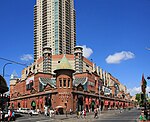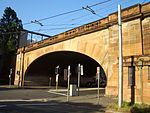Christ Church St Laurence is an Anglican church located at 814 George Street, near Central railway station and Haymarket, in Sydney, New South Wales, Australia. It is the principal centre of Anglo-Catholic worship in the city and Diocese of Sydney, where the Anglican church is predominantly Evangelical in character. Anglo-Catholicism is manifested at Christ Church St Laurence by an emphasis on the sacraments, ritual, music and social action, all of which have been prominent features of Anglo-Catholicism since the 19th century.
The parish dates from 1838 and the church building from 1845. It was the first Anglican church in the city to be consecrated by a bishop and is the second-oldest of the city's Anglican church buildings still in use. The first architect was Henry Robertson, who was soon succeeded by Edmund Blacket, a major figure in Australian architectural history and a parishioner of Christ Church St Laurence, to whom the church owes many of its notable features. The church was added to the New South Wales State Heritage Register on 2 April 1999.The choir of Christ Church St Laurence has a high reputation among Anglican parish choirs. It performs a repertoire ranging from Gregorian chant to 21st-century works. In existence for the consecration of the church in 1845, and possibly earlier, it is one of the oldest choral groups in Australia. The church's pipe organ was built by William Hill & Son, of London, in 1891 and installed in 1906. It is also listed on the NSW State Heritage Register.The church has an active program of support for people who are socially marginalised, including the homeless and asylum seekers. This work originates in the social character of the parish's neighbourhood, which has a history of poverty, immigration, and transience. Social action will increase in future years, following the creation of the separately administered Christ Church St Laurence Charitable Trust.









